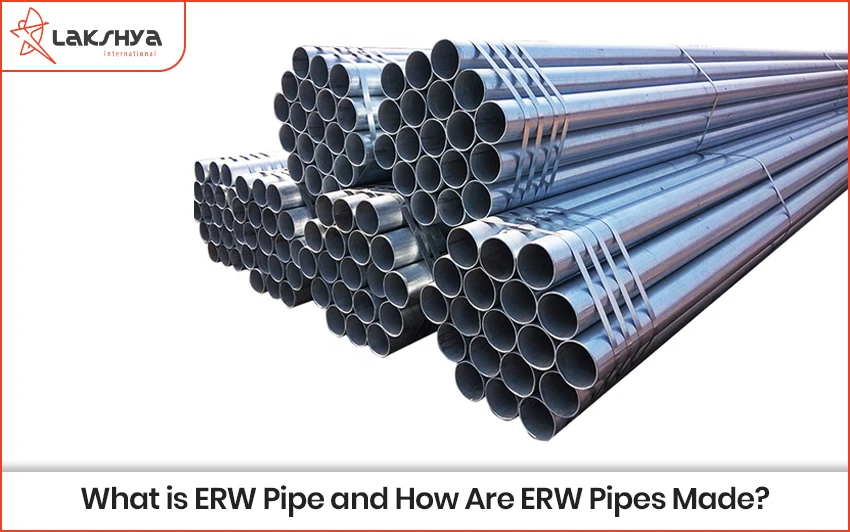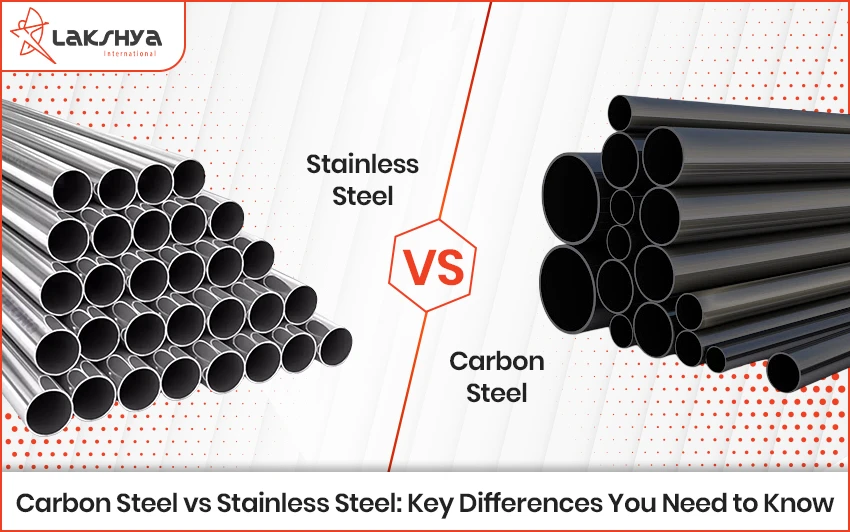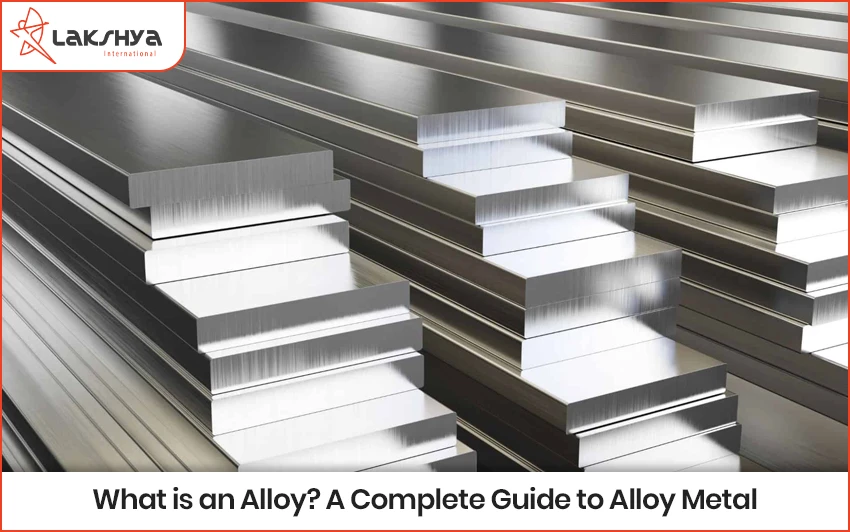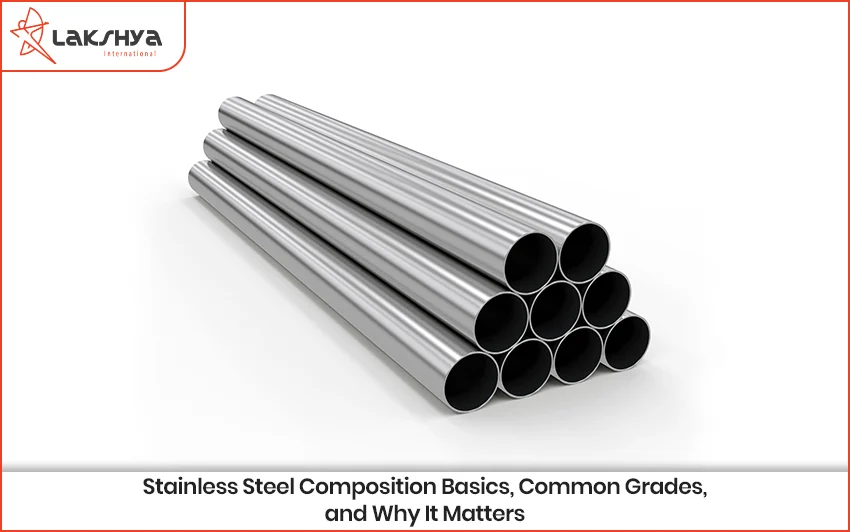In this straightforward guide from Lakshya Steel, we’re going to get into what an ERW pipe really is. We’ll explain the ERW pipe in full form clearly. We’ll also walk you through how these pipes are made, show you the common ERW pipe types you can find and give you the lowdown on their specifications. Plus, we’ll compare them to other pipes and talk about where they’re used. Our aim is to give you all the info you need to choose the right ERW pipes for your projects.
What is an ERW Pipe?
The “ERW” part means Electric Resistance Welded. Think of an ERW pipe as a steel pipe that starts life as a flat piece of metal. This flat metal is rolled up, and then the borders are welded together lengthwise. The cool part is how it’s welded: it uses electric resistance to create heat. This heat melts the borders just enough so they can be pressed together to form a strong bond, all without adding any extra welding metal.
In simple terms imagine taking a flat sheet of steel (called a skelp) bending it into a circle and then welding the meeting borders together using electricity. That’s your ERW pipe.
Yes, that’s what it stands for – a pipe welded using electric resistance.
Key Characteristics of ERW Pipes
- There’s a weld line running down the length of the pipe.
- The thickness of the pipe wall is pretty much the same all around.
- They’re made to very precise sizes.
- No extra metal is used to make the weld.
- They’re great for jobs where the pressure isn’t super high.
How ERW Pipes Are Made: The Manufacturing Process Step-by-Step
Here are the main steps in ERW pipe manufacturing:
- Unrolling and flattening the steel
- Trimming the edges
- Bending it into shape
- Welding (with electricity!)
- Making sure it’s the right size
- Cutting it to length
- Testing it thoroughly
- Finishing touches and bundling them up
Detailed Steps in ERW Pipe Manufacturing
- Getting the Material Ready
- Big rolls of steel (either hot-rolled or cold-rolled, usually plain carbon steel) are unrolled and flattened out.
- The edges of this flat steel are trimmed so they’re perfectly straight and the right width.
- Forming the Pipe
- This trimmed flat steel strip (now called skelp) goes through a series of rollers.
- These rollers slowly bend the strip, bit by bit, until it forms a round tube with the edges almost touching.
- Welding (The ERW Part!)
- The borders of the tube are heated up using a powerful, high-frequency electric current.
- When the borders get hot enough to weld pressure rollers squeeze them together. This makes them fuse and form a solid bond.
- No extra welding material is needed. Any little bit of metal that squeezes out (the weld bead) is trimmed off.
- Sizing and Straightening
- The welded tube then passes through more rollers called sizing rolls. These make sure the outside diameter is exactly right.
- Straightening machines then take out any kinks or bends.
- Cutting and Testing
- The long pipe is cut into the lengths needed (like 6 meters or 12 meters).
- Then comes testing: things like checking for leaks with water pressure (hydro testing), looking for hidden flaws (non-destructive testing), and a good old visual check.
- Finishing and Bundling
- The ends might be smoothed (deburring), the pipe might be painted, or threads might be cut into the ends.
- Finally, the pipes are bundled together and sent off.
Common ERW Pipe Types
- MS ERW Pipe (Mild Steel ERW Pipe): Your standard ERW pipe, made from everyday mild steel.
- Black ERW Pipe: This is an ERW pipe with a natural, uncoated dark finish from the steel-making process.
- Galvanized ERW Pipe: These ERW pipes have a zinc coating to stop them from rusting.
- Pre-painted ERW Pipe: ERW pipes that come already painted from the factory.
- Heavy Wall ERW Pipe: ERW pipes with thicker walls for tougher jobs.
ERW Pipe Specifications
| Specification | Description |
| Size Range | From about ½ inch up to 24 inches across (outside diameter). |
| Wall Thickness | Usually between 1.2mm and 12.7mm thick. |
| Length | Can be custom, but standard is often 6 meters or 12 meters. |
| Material Grades | Common ones are IS 1239, IS 3589 (Indian), ASTM A53, API 5L (American). |
| Ends | Can be plain, angled for welding (beveled), or threaded. |
| Tolerance | How much the size can vary, usually set by ASTM or API rules. |
Benefits of ERW Pipes
- Cost-Effective: They usually cost less to make than seamless pipes.
- Efficient Production: They can be made quickly and in large amounts.
- Dimensional Accuracy: They’re made to very precise sizes, which is great if you need a tight fit.
- Smooth Surface Finish: They usually have a nice, smooth surface.
- Widely Available: Easy to find in lots of sizes and types.
Uses and Applications of ERW Pipes
You’ll find ERW pipes doing all sorts of jobs in many industries:
Industries Served:
- Oil & Gas: For carrying oil and gas.
- Water and Sewage Systems: For water supply pipes and wastewater lines.
- Scaffolding: The poles and frames used in construction.
- Structural Fabrication: For building frames and supports.
- Fencing and Agricultural Projects: For fence posts and greenhouse frames.
- HVAC: For heating and cooling system pipes.
Use Cases:
- Water pipes for towns and cities.
- Pipes for firefighting systems.
- Frames for greenhouses.
- Gas lines for medium to low pressure.
ERW Pipes vs Seamless Pipes
What’s the difference between ERW and seamless pipes?
| Feature | ERW Pipes | Seamless Pipes |
| How It’s Made | Flat steel rolled and welded with electricity. | Made from a solid block of steel, no weld. |
| Cost | Usually cheaper. | Generally more expensive. |
| Availability | Easy to find. | Can be harder to find in some sizes. |
| Pressure Handling | Good for medium pressure. | Better for very high pressure. |
| Weld Line | Yes (but it’s trimmed down). | No weld line at all. |
ERW Pipe Price Range (Estimate for 2025)
- Current Market Rate (Roughly):
- MS ERW Pipe: Around INR 55 – 75 per kilogram, depending on size and type.
- Galvanized ERW Pipe: Around INR 65 – 85 per kilogram.
- What Affects the Price:
- Cost of raw steel.
- How thick and big the pipe is.
- Any coatings (like galvanizing) or special finishes.
- How much demand there is in the market.
For today’s prices, it’s best to check Lakshya Steel’s product pricing page or get in touch.
ERW Pipe Weight Chart (Per Meter)
| Nominal Size (inches) | Thickness (mm) | Weight ( kg/m ) (Approx.) |
| 1″ | 2.5 | 2.37 |
| 2″ | 3.0 | 5.44 |
| 3″ | 3.2 | 8.33 |
| 4″ | 4.0 | 13.44 |
ERW Pipe Manufacturers in India
Lakshya Steel is proud to be one of the top ERW pipe manufacturers in India. We offer:
- Mild steel ERW pipes that meet Indian Standards (IS).
- Pipes cut to the length you need, with different finishes.
- We can supply pipes all over India and also export them.
Conclusion
So, ERW pipes are a really important part of today’s building and industrial projects. They are a wise choice because they work well, don’t break the bank and are made accurately. Whether you are an engineer, a buyer or run a construction business, knowing about how ERW pipes are made and what they can do helps you choose wisely.
Ready to find the right pipes? Explore Lakshya Steel’s ERW Pipe range to get started.
FAQs About ERW Pipes
What is ERW piping?
ERW piping is just another way to say Electric Resistance Welded pipes. They’re steel pipes made by welding the edges together using electric current.
What is the difference between ERW & seamless pipe?
What is the difference between ERW and MS pipe?
MS means “Mild Steel” – that’s the type of steel the pipe is made from. ERW refers to how the pipe is made (Electric Resistance Welded). So, an MS ERW pipe is a pipe made from mild steel using the ERW method.
What is the difference between ERW pipe and GI pipe?
A GI (Galvanized Iron) pipe is a steel pipe that’s been coated with zinc to stop rust. ERW pipe refers to how it’s made. A GI pipe can be an ERW pipe that has then been galvanized.
What does ERW stand for?
ERW stands for Electric Resistance Welded.
Is ERW pipe suitable for high-pressure applications?
Generally, ERW pipes are good for low to medium pressure. For very high-pressure jobs, seamless pipes are often the first choice.
How strong is the weld in an ERW pipe?
Modern ERW welding makes a weld that’s just about as strong as the steel itself. It’s perfectly fine for what these pipes are designed to do in buildings and pipelines.




